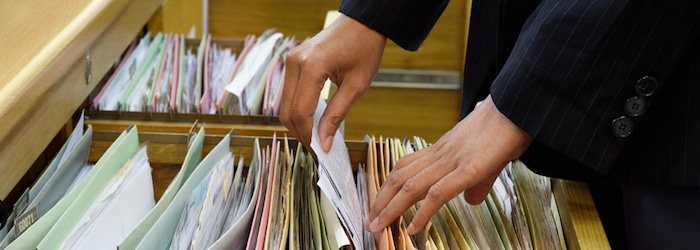The file cabinet – that mainstay of the office – could be compromising both your office’s productivity and information security.
Even small and medium-sized businesses that have long embraced fundamental online functionality like email and web meetings may still be tied to hard copies for their documentation; thus the ongoing presence of file cabinets.
But even within those sturdy-looking metal drawers, documentation is at risk:
- Unless constantly kept locked, a file cabinet is easy prey for almost anybody who may want to access what’s inside; think of the consequences for files like tax records or customer histories.
- Flooding, fire, or even mould and mildew can do permanent damage to a file cabinet and its contents.
What’s more, for every piece of paper in a file cabinet, there’s a person on your staff performing the manual labour of retrieving the hard copy from the printer, finding its rightful place in the cabinet and, perhaps, being tasked to take it out again someday.
“The average document is copied 9 to 11 times, and every 12 filing cabinets
require an additional employee to maintain.” – The Paperless Project
Sounds easy, but it’s a time-consuming ritual that doesn’t take into account the possibility of human error, like misfiling or even losing a document. And if the cabinets are constantly locked for security purposes, the “keyholder’s” absence on a certain day may slow down productivity for the rest of the staff.
The solution? Go digital
Technology has made it a fairly easy process to convert hard copies to digital, delivering peace of mind along with a simply better storage solution.
- It takes just seconds to save, share and store a digital document, compared to the minutes, or even hours, workers may otherwise spend digging through a file cabinet each week.
- Thanks to cloud technology, digitized documents are more easily available to people working remotely; at the same time, the files are kept secure via password and encryption protection.
- Digitization fosters better use of analytics, so your legacy documents can contribute to a clearer history of your company’s growth and development.
Finally, going digital saves material cost like paper and toner that would otherwise be used to create hard copies. Similarly, a more “paperless” office is a more eco-friendly office.
Ready to know more?
You can reduce your need for file cabinets and realize better productivity by digitizing your documents. Talk to a Managed Print Services provider about a free print assessment of your workplace that will show where you can save money and time.
Are you wondering how your printing practices stack up against other small and mid-sized businesses? Take our SMB Office Challenge today! You could qualify to win one of five Xerox multifunction colour printers and receive a FREE 2016 Office Print Policy Guide full of money saving best practices!





